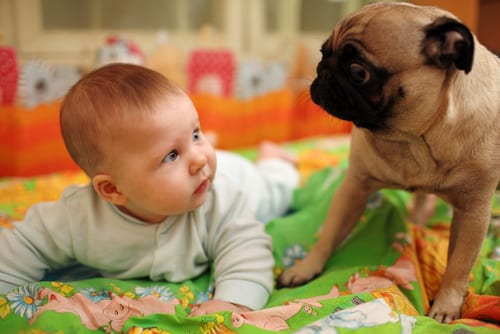Is a baby in your future? If so, it’s never too early to start preparing your pet for the changes your household is about to undergo. In fact, the earlier you begin training your car or dog, the less likely you’ll encounter issues when you baby arrives.

Brush Up on Obedience
It’s essential that you teach your pet to obey your commands before the baby arrives. Waiting until you’re sleep deprived, stressed, and emotionally drained to begin working on obedience is just going to end in frustration on everyone’s part. Working with a professional trainer is a great way to gain insight into behaviors you may not see and ensure that you are being consistent in your training style. There are even classes and trainers who specifically focus on working with expectant families.
The Arizona Animal Welfare League, for instance, offers a 90-minute class for you and your dog, covering basic behavior training and tips to prepare your entire family for a new member. The next session is scheduled for Saturday, August 17th from 1:00-3:00 pm. To register, visit the Arizona Animal Welfare League website or contact Rachel Gardner at rgardner@aawl.org.
Make Routine Changes
This is a great time to set some new boundaries. If you have a nursery, you may want to make it a pet-free zone. By putting up a baby gate now, before baby actually arrives, will help establish that it’s an off-limits area.
You should also take a step back and evaluate the kind of behavior you’ve allowed up to this point. Perhaps your dog leaps onto the sofa with you every time you sit down. Up until now, that hasn’t been an issue; however, if you think about him bounding into your lap while you’re trying to feed the baby, you may not feel the same way. Set the ground rules now so that good behavior is already in place before you bring the baby home.
You may want to role-play using a doll or stuffed animal so that your pet becomes accustomed to the sight in advance. Practice having your pet sit patiently and wait to be invited to approach you. Allow your pet to sniff the doll, praising and rewarding them for positive behavior. These pretend scenarios can go a long way in helping your pet ease into the real life scenes right around the corner
Role Shift
If mom has been the primary pet caretaker, it may be time to make some changes to account for the changes in her energy levels (and likely, her availability) after the baby arrives. Start by alternating feedings and walking to gently ease them into a new routine. While you’re working out your new routines, this is a great time to start planning who will be in charge of which duties once the baby arrives so nothing gets overlooked.
If mom’s been in charge of litter box duties, she should relinquish that responsibility immediately. Due to concerns about toxoplasmosis, a disease-causing parasite often found in cat’s feces, pregnant women should avoid contact with the cat’s litter box.
The Sniff Test
To help your pet acclimate to the scent of their new family member, bring home something from the hospital with your baby’s scent—perhaps a blanket or outfit. Allow them to sniff the new item and praise them for being gentle and calm. If you’ve been role playing with a doll, use this new blanket or outfit with the doll to further the association. While it may feel silly, you may also want to practice taking your dog for a walk while pushing a stroller. There’s a bit of finesse involved in keeping everyone moving without getting intertwined and it’s nice to have these kinks worked out in advance.
The Introduction
Before introducing your pet to the new baby, take time to engage your pet in an activity that will tire them out. A long walk or play session will ensure that they are not full of pent up energy for their first meeting with your little bundle of joy. This is especially important if they’ve spent the last few days in unfamiliar surroundings while you’ve been at the hospital.
Greet your pet first—without the baby. Then, after you’ve ensured your pet is in a calm, controlled state, introduce them to each other while keeping them at a safe distance and being respectful of your pet’s interest in the new arrival. Remember to lavish praise and treats on your pet for good behavior. Watch for signs of stress and remove the baby from the room if your pet seems agitated. If your pet is still having trouble adjusting after the first few weeks, seek advice from your vet.
Try to keep routines as normal as possible with your pet, feeding, walking, playing, and sleeping according to the schedule you’ve been working on over the past few months. Also, make sure to create time for the whole family to be together so that your pet can acclimate to all the new sounds and activities. Sometimes families will have their pet leave the room every time the baby is around. Rather than eliminating potential problems, this often has the opposite effect—creating a negative association to the baby.
Lastly, regardless of how gentle your dog behaves around your baby, never leave dogs and children together unattended. It only takes a minute for the unthinkable to happen.
For pets who have long been at the center of your world, it can be hard coping with all the changes a baby brings. However, with a bit of advance planning and preparation—and a lot of praise and patience—the entire family can relish in the joys of a new baby.

